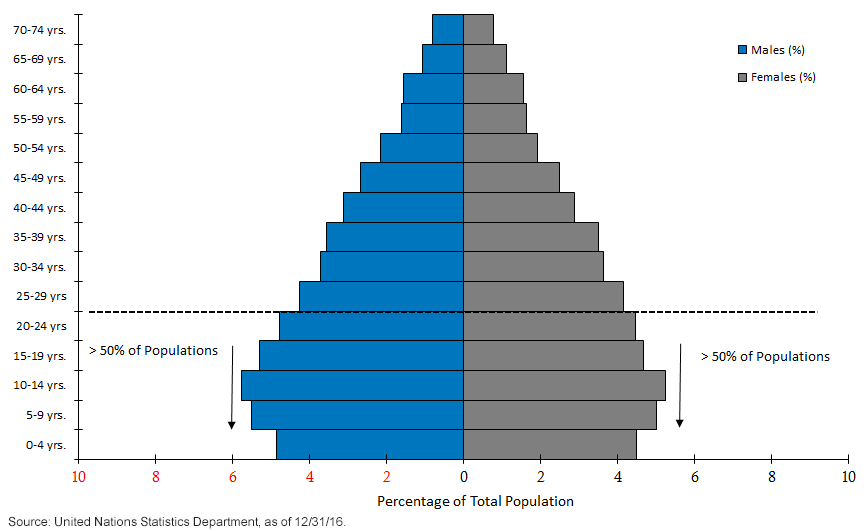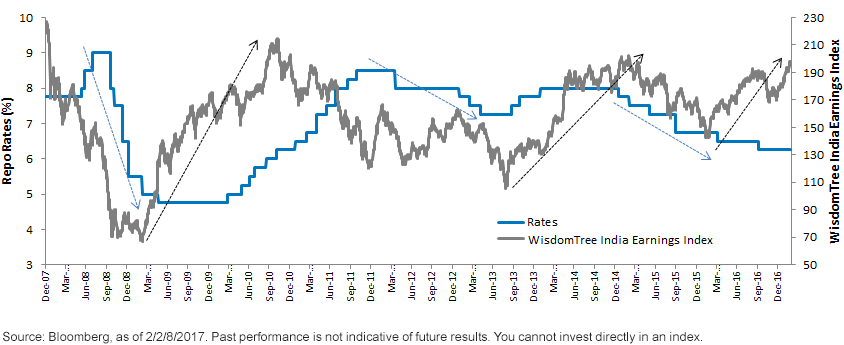This Tiger Just Started Charging—Investors, Take Note


So far, 2017 has been a good year for most risky assets globally, in my view. As of March 10, the S&P 500 was up by about 6.4%, as were the majority of equity markets around the world, including India. However, there is more to India’s recent outperformance than merely global markets being on a “risk-on” mode. So far in 2017, Indian equities are among the best-performing emerging market (EM) equities, with the MSCI India Index beating the MSCI Emerging Markets Index by over 330 basis points (bps) on a year-to-date basis.1
For EM investors, I believe, Indian equities make a compelling tactical case for a portfolio over-weight in 2017. Political stability and strategic macro drivers are feeding this Asian tiger with just enough energy to accelerate its growth.
Political Stability Could Mean More Reforms in 2017
India’s most populous state, Uttar Pradesh (UP), recently voted for state elections. With a population of about 205 million, if UP were a country, it would be the fifth-largest country in the world. With the backdrop of a surprise demonetization that caused people a lot of inconvenience, everybody expected Prime Minister Narendra Modi’s party, BJP, to lose considerably.
However, in this season of political surprises, Modi’s BJP won a decisive and an unprecedented 80% mandate. Not only is this a big thumbs-up to Modi’s governance, but, more importantly, this will boost the party’s numbers in the upper house, where a lack of a majority by the BJP has often hindered the approval of key but tough reforms. Also, UP’s verdict sets a strong tone for Modi’s re-election in 2019.
An immediate consequence of this recent election could be a faster and smoother implementation of India’s much-awaited taxation overhaul, the Goods and Services Tax Bill this year. With a renewed mandate and more confidence, we expect the Modi government to implement more reforms in 2017 and 2018 that will continue to make India an attractive destination for investment.
Political stability is critical for economic growth and markets to do well. What we are looking at in India right now is a federal government that has a clean mandate, states that are giving strong verdicts for reforms and strong trends for re-election of the current federal government.
Demographics and Consumption Feed Strategic Macro Growth
Another key concern after demonetization was the impact on India’s growth. However, much to everyone’s surprise, India continues to be the only large economy tracked by the IMF that is growing at 7% or more, based on the latest gross domestic product numbers. In 2016, India not only surpassed China in terms of GDP acceleration, but it’s expected to grow at 7% to 7.5% for the foreseeable future. In a world that is growing at about 3% to 4%, India’s growth is almost two times the global average.2
I believe India’s strong consumption-based economic model and its young demographics are the much-needed energy reservoirs that will fuel India’s future growth rates. With two-thirds of its population below the age of 35 and half of its population below 25 years old, the country is very young.3
Nearly 12 million to 14 million people enter India’s workforce every year, and the Modi government has launched an aggressive campaign to create 400 million jobs by 2020 through a full host of plans.4 Additional jobs will further feed into consumption and spending.
India's Demographic Distribution

Active Monetary Policy Feeds Tactical Market Returns
Market performance is equally important for investors, and this is where I believe an active central bank is fueling earnings expansion for corporate India.
In 2013, when crude oil traded above $100 per barrel, India, as the third-largest oil importer in the world, spent nearly 38% of its imports on crude oil. In 2016, this number stood near 20%, almost half the previous level.5
As fiscal tailwinds helped in inflation easing, the Reserve Bank of India (RBI) took this opportunity and launched a successive rate-cut campaign. So far, we have seen 175 bps of consecutive rate cuts since January 2015. Now with inflation bottoming out, I believe India is heading toward the end of the cycle of rate cuts. Most state-owned and public banks in India have already lowered lending rates by 1% to 1.5%, and the RBI has been nudging them to pass on remaining rate cuts to the end customer.6 This rate-cut environment could help boost earnings with a lag as the lower cost of credit jump-starts the economic engine.
The last two times that RBI engaged in a consecutive rate cuts, the WisdomTree India Earnings Index (WTIND) responded with double-digit total returns in the year that immediately followed. Thus, solid performance by Indian markets in 2017 so far should not come as a surprise.
WisdomTree India Earnings Index Reacting Positively to Rate Cuts (12/31/07–2/28/17)


The WisdomTree India Earnings Index is an earnings-weighted index that provides access to profitable companies eligible to be purchased by foreign investors. It is a comprehensive exposure to a profitable segment of Indian equities.
Conclusion
The World Bank classifies India as a lower-middle-income country, with a per capita income of $1,300. However, as per projected IMF trends, India’s per capita income would surpass $4,000 over the next decade, and it will become an upper-middle-income country.7 This would make India the only country in the world to improve income classification within a decade, with the help of a stable democracy’s checks and balances.
I believe we are witnessing a multitrillion-dollar wealth generation opportunity, and investors who are willing to participate in India’s economic expansion stand to realize the potential upside.
1Source: Bloomberg, as of 3/10/17.
2Source: World Bank, as of 12/31/16.
3Source: United Nations Statistics Department, as of 12/31/16.
4Source: Government of India, as of 12/31/16.
5Source: Bloomberg, as of 12/31/2016.
6Source: Reserve Bank of India, as of 12/31/16.
Important Risks Related to this Article
Investments focused in India increase the impact of events and developments associated with the region, which can adversely affect performance.Double-digit returns were achieved primarily during favorable market conditions. Investors should not expect that such favorable returns can be consistently achieved.


